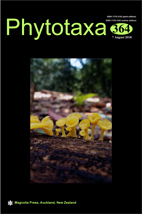Abstract
Isoetes is a worldwide aquatic plant group with ca. 250 species. In South America, Isoetes luetzelburgii is one of the few species that inhabits semi-arid areas. This is an endangered species known from only few collections, which causes uncertainty related to its morphological delimitation, distribution and conservation status. Efforts combining both field and herbarium investigations enabled us to identify several new populations in northern Brazil. In this study, we present a comprehensive assessment of the known distribution of I. luetzelburgii and provide a detailed description of the species. Because the holotype was never properly designated, we also provide the lectotypification for the name. The data presented here contribute to enhance our understanding of the taxonomy and natural history of this species. This understanding may also serve as a conservation tool for the protection of its populations.
References
https://doi.org/10.3897/zookeys.150.2109
Brunton, D.F. (2015) Key to the Quillworts (Isoetes: Isoetaceae) of the Southeastern United States. American Fern Journal 105: 86?100.
https://doi.org/10.1640/amfj-105-02-86-100.1
Chinnock, R.J. (1998) Isoetaceae. In: Patrick M. McCarthy (Ed.) Flora of Australia volume 48; ferns, gymnosperms and allied groups. ABRS/CSIRO Australia, Melbourne, pp. 55–65.
Cox, P.A. & Hickey, R.J. (1984) Convergent megaspore evolution and Isoetes. American Naturalist 124: 437–441.
https://doi.org/10.1086/284285
Fuchs-Eckert, H.P. (1982) Zur heutigen Kenntnis von Vorkommen and Verbreitung der südermerikanischen Isoetes-Arten. Proceedings of the Koninklijke Nederlandse Akademie van Wetenschappen, Series C 85: 205?260.
Hickey, R.J. (1985) Revisionary studies of Neotropical Isoetes. Ph.D. Dissertation, Storrs, 327 pp.
Hickey, R.J. (1986a) Isoetes megaspore surface morphology: nomenclature, variation, and systematic importance. American Fern Journal 76: 1?16.
https://doi.org/10.2307/1547394
Hickey, R.J. (1986b) The early evolutionary and morphological diversity of Isoetes, with descriptions of two new Neotropical species. Systematic Botany 11: 309–321.
https://doi.org/10.2307/2419121
IBGE (2002) Mapa de clima do Brasil. IBGE, Rio de Janeiro. Available from: https://mapas.ibge.gov.br/tematicos.html (accessed 22 February 2018)
IBAMA (2008) Lista Oficial das Espécies da Flora Brasileira Ameaçadas de Extinção, Instrução normativa n° 6, de 23 de setembro de 2008. Available from: www.mma.gov.br/estruturas/179/_arquivos/179_05122008033615.pdf (accessed 26 March 2018)
IPCC (2007) Climate change: the physical science basis. In: Solomon, S., Qin, D., Manning, M., Chen, Z., Marquis, M., Averyt, K.B., Tignor, M. & Miller, H.L. (Eds.) Contribution of working group I to the fourth assessment report of the intergovernmental panel on climate change. Cambridge University Press, Cambridge, 996 pp.
Linnaeus, C. (1753) Species Plantarum 2. L. Salvius, Stockholm, 1200 pp.
Macluf, C., Torres, E.I.M. & Solís, S.M. (2010) Isoetes pedersenii, a new species from Southern South America. Anais da Academia Brasileira de Ciências 82: 353?359.
https://doi.org/10.1590/S0001-37652010000200011
McNeill J. (2014) Holotype specimens and type citations: general issues. Taxon 63: 1112?1113.
https://doi.org/10.12705/635.7
McNeill J., Barrie, F.R., Buck, W.R., Demoulin, V., Greuter, W., Hawksworth, D.L., Herendeen, P.S., Knapp, S., Marhold, K., Prado, J., Prud’homme van Reine, W.F., Smith, G.F., Wiersema, J.H. & Turland, N.J. (2012) International code of nomenclature for algae, fungi, and plants (Melbourne Code) adopted by the Eighteenth International Botanical Congress Melbourne, Australia. Koeltz Scientific Books, Königstein, 208 pp.
MMA/IBAMA (2011) Monitoramento do desmatamento dos biomas brasileiros por satélite–Monitoramento do Bioma Caatinga. Available from: http://siscom.ibama.gov.br/monitorabiomas/caatinga/caatinga.htm (accessed 17 May 2018)
Moro, M.F., Lughadha, E.N., de Araújo, F.S. & Martins, F.R. (2016) A phytogeographical metaanalysis of the semiarid Caatinga domain in Brazil. Botanical Review 82: 91?148.
https://doi.org/10.1007/s12229-016-9164-z
Musselman, L.J. & Roux, J.P. (2002) Isoetes toximontana (Isoetaceae), a new quillwort with green megaspores from Northern Cape of South Africa. Novon 12: 504?507.
https://doi.org/10.2307/3393131
Pereira, J.B.S., Salino, A., Arruda, A. & Stützel, T. (2016) Two new species of Isoetes (Isoetaceae) from northern Brazil. Phytotaxa 272 (2): 141–148.
https://doi.org/10.11646/phytotaxa.272.2.5
Pereira, J.B.S., Mittelbach, M. & Labiak, P.H. (2015) Studies on chromosome numbers and spore size in Brazilian Isoëtes. American Fern Journal 105: 226–237.
https://doi.org/10.1640/0002-8444-105.3.226
Punt, W., Hoen, P.P., Blackmore, S., Nilsson†, S. & Le Thomas, A. (2007) Glossary of pollen and spore terminology. Review of Palaeobotany and Palynology 143: 1–81.
https://doi.org/10.1016/j.revpalbo.2006.06.008
R Core Team (2013) A language and environment for statistical computing, R Foundation for Statistical Computing, Wien. Available from: http://www.R-project.org/ (accessed 10 August 2018)
Taylor, W.C., Luebke, N.T. & Smith, M.B. (1985) Speciation and hybridisation in North American quillworts. Proceedings of the Royal Society of Edinburgh 86B: 259?263.
https://doi.org/10.1017/S0269727000008216
Taylor, W.C., Luebke, N.T., Britton, D.M., Hickey, R.J. & Brunton, D.F. (1993) Isoetaceae. In: Flora of North America Editorial Committee (Eds.) Flora of North America, Volume II: Pteridophytes and Gymnosperms. Oxford University Press, New York, pp. 64–75.
Thiers, B. (2016, continuously updated) Index Herbariorum: A global directory of public herbaria and associated staff. New York Botanical Garden‘s Virtual Herbarium. Available from: http://sweetgum.nybg.org/science/ih/ (accessed 1 August 2016)
Troia, A. (2001) The genus Isoetes L. (Lycophyta, Isoetaceae): synthesis of karyological data. Webbia 56 (1): 201–218.
https://doi.org/10.1080/00837792.2001.10670712
Troia, A., Pereira, J.B.S., Kim, C. & Taylor, W.C. (2016) The genus Isoetes (Isoetaceae): a provisional checklist of the accepted and unresolved taxa. Phytotaxa 277 (2): 101–145.
https://doi.org/10.11646/phytotaxa.277.2.1
Weber, U. (1922) Zur Anatomie und Systematik der Gattung Isoëtes L. Hedwigia 63: 219–262.
Weber, U. (1926) Quinta Classe: Isoetales. Estudo Botanico do Nordéste 3: 256–257.
Weber, U. (1934) Neue südamerikanische Isoetes-Arten. Berichte der deutschen botanischen Gesellschaft 52: 121–125.

